-
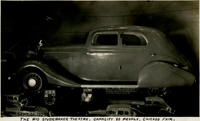 McCarthy Album 11, Photograph 282
McCarthy Album 11, Photograph 282 Caption: "Sept. 20, 1934, The Big Studebaker Theatre. Capacity 80 People. Chicago Fair." This giant replica of a 1934 Studebaker Land Cruiser at the Century of Progress Exposition, made of plaster over a wood frame, sat above a small theater capable of sitting eighty people. The Exposition, a world fair attended by thirty-nine million people, celebrated Chicago's one-hundred year anniversary of incorporation. Originally planned to only run from May to November in 1933, it was such a success that its organizers decided to keep it running for a second season from May through October the following year. The central theme of the Exposition was technological innovation, with a motto of "Science Finds, Industry Applies, Man Conforms."
-
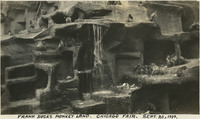 McCarthy Album 11, Photograph 281
McCarthy Album 11, Photograph 281 Caption: "Frank Bucks [sic] Monkey Land. Chicago Fair. Sept. 20, 1934." View of a rocky cliff populated by a species of monkey. This was part of a display at Frank Buck's Jungle Camp, an exhibition at Chicago's Century of Progress Exposition. The Exposition, a world fair attended by thirty-nine million people, celebrated Chicago's one-hundred year anniversary of incorporation. Originally planned to only run from May to November in 1933, it was such a success that its organizers decided to keep it running for a second season from May through October the following year. The central theme of the Exposition was technological innovation, with a motto of "Science Finds, Industry Applies, Man Conforms."
-
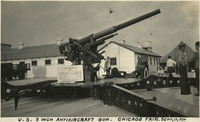 McCarthy Album 11, Photograph 280
McCarthy Album 11, Photograph 280 Caption: "U.S. 3 Inch Antiaircraft [sic] Gun. Chicago Fair. Sept, [sic] 19, 1934." View of a 3"/50 caliber anti-aircraft gun, a heavy artillery weapon used by the US Navy and Coast Guard. The weapon was part of a display at Chicago's Century of Progress Exposition. The Exposition, a world fair attended by thirty-nine million people, celebrated Chicago's one-hundred year anniversary of incorporation. Originally planned to only run from May to November in 1933, it was such a success that its organizers decided to keep it running for a second season from May through October the following year. The central theme of the Exposition was technological innovation, with a motto of "Science Finds, Industry Applies, Man Conforms."
-
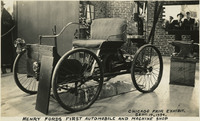 McCarthy Album 11, Photograph 279
McCarthy Album 11, Photograph 279 Caption: "Henry Ford's First Automobile and Machine Shop, Chicago Fair Exhibit. Sept. 19, 1934." This exhibit within the Ford Building at Chicago's Century of Progress Exposition replicated Henry Ford's original workshop, including a Quadricycle, the first automobile produced by Ford. The Exposition, a world fair attended by thirty-nine million people, celebrated Chicago's one-hundred year anniversary of incorporation. Originally planned to only run from May to November in 1933, it was such a success that its organizers decided to keep it running for a second season from May through October the following year. The central theme of the Exposition was technological innovation, with a motto of "Science Finds, Industry Applies, Man Conforms."
-
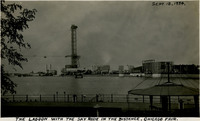 McCarthy Album 11, Photograph 278
McCarthy Album 11, Photograph 278 Caption: "The Lagoon with the Sky Ride in the distance. Chicago Fair. Sept. 18, 1934." Dominating this photograph is one of the 628-foot towers making up the Sky Ride, an aerial tramway which carried fair goers in small gondolas or trams (visible just to the left of the tower) over the harbor around which the Century of Progress Exposition was held. Over 4.5 million passengers enjoyed the views from the Sky Ride before it was demolished after the conclusion of the exposition in 1934. The Exposition, a world fair attended by thirty-nine million people, celebrated Chicago's one-hundred year anniversary of incorporation. Originally planned to only run from May to November in 1933, it was such a success that its organizers decided to keep it running for a second season from May through October the following year. The central theme of the Exposition was technological innovation, with a motto of "Science Finds, Industry Applies, Man Conforms."
-
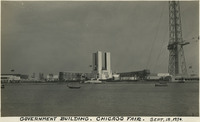 McCarthy Album 11, Photograph 277
McCarthy Album 11, Photograph 277 Caption: "Government Building. Chicago Fair. Sept. 18, 1934." View of the Federal Building at Chicago's Century of Progress Exposition, as seen from across the harbor. The three tall towers represent the three branches of the federal government. This building, towering over the Exposition, was featured on a commemorative US Postage Stamp issued in honor of the Exposition. A world fair attended by thirty-nine million people, the Expo celebrated Chicago's one-hundred year anniversary of incorporation. Originally planned to only run from May to November in 1933, it was such a success that its organizers decided to keep it running for a second season from May through October the following year. The central theme of the Exposition was technological innovation, with a motto of "Science Finds, Industry Applies, Man Conforms."
-
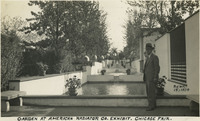 McCarthy Album 11, Photograph 276
McCarthy Album 11, Photograph 276 Caption: "Garden at American Radiator Co. Exhibit. Chicago [sic] Fair. Sept. 18, 1934." William McCarthy stands in front of a series of pools cascading into one another, surrounded by manicured plants at the Century of Progress Exposition. The Exposition, a world fair attended by thirty-nine million people, celebrated Chicago's one-hundred year anniversary of incorporation. Originally planned to only run from May to November in 1933, it was such a success that its organizers decided to keep it running for a second season from May through October the following year. The central theme of the Exposition was technological innovation, with a motto of "Science Finds, Industry Applies, Man Conforms."
-
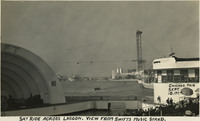 McCarthy Album 11, Photograph 275
McCarthy Album 11, Photograph 275 Caption: "Sky Ride Across Lagoon. View from Swifts Music Stand. Chicago Fair, Sept. 18, 1934." One of the 628-foot towers making up the Sky Ride, an aerial tramway which carried fair goers in small gondolas or trams (visible in the center of the photograph) over the harbor around which the Century of Progress Exposition was held. Over 4.5 million passengers enjoyed the views from the Sky Ride before it was demolished after the conclusion of the exposition in 1934. The Exposition, a world fair attended by thirty-nine million people, celebrated Chicago's one-hundred year anniversary of incorporation. Originally planned to only run from May to November in 1933, it was such a success that its organizers decided to keep it running for a second season from May through October the following year. The central theme of the Exposition was technological innovation, with a motto of "Science Finds, Industry Applies, Man Conforms."
-
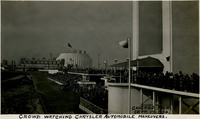 McCarthy Album 11, Photograph 274
McCarthy Album 11, Photograph 274 Caption: "Crowd Watching Chrysler Automobile Maneuvers. Chicago Fair. Sept. 17, 1934." Fairgoers pack the stands at a demonstration of the capabilities of Chrysler automobiles on a track created as part of the Chrysler complex built for the Exposition. The Exposition, a world fair attended by thirty-nine million people, celebrated Chicago's one-hundred year anniversary of incorporation. Originally planned to only run from May to November in 1933, it was such a success that its organizers decided to keep it running for a second season from May through October the following year. The central theme of the Exposition was technological innovation, with a motto of "Science Finds, Industry Applies, Man Conforms."
-
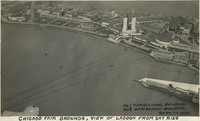 McCarthy Album 11, Photograph 273
McCarthy Album 11, Photograph 273 Caption: "Chicago Fair Grounds, View of Lagoon from Sky Ride. No 1 Agricultural Building. No2 Government Building. Sept. 17, 1934." Bird's eye view of a portion of the fair grounds for Chicago's Century of Progress Exposition. Two of the fair's structures have been labeled in this photograph, including the Agriculture Building, a long low structure, and the Federal Building, featuring three towers representing the three branches of the federal government. The Exposition, a world fair attended by thirty-nine million people, celebrated Chicago's one-hundred year anniversary of incorporation. Originally planned to only run from May to November in 1933, it was such a success that its organizers decided to keep it running for a second season from May through October the following year. The central theme of the Exposition was technological innovation, with a motto of "Science Finds, Industry Applies, Man Conforms." None of the buildings constructed for the fair are still extant today, having been built as temporary facilities.
-
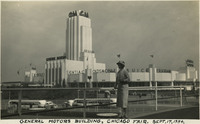 McCarthy Album 11, Photograph 272
McCarthy Album 11, Photograph 272 Caption: "General Motors Building, Chicago Fair. Sept. 17, 1934." Grace McCarthy stands at a railing with the General Motors Building in the background. The building was part of the Century of Progress Exposition, a world fair attended by thirty-nine million people, celebrated Chicago's one-hundred year anniversary of incorporation. Originally planned to only run from May to November in 1933, it was such a success that its organizers decided to keep it running for a second season from May through October the following year. The central theme of the Exposition was technological innovation, with a motto of "Science Finds, Industry Applies, Man Conforms." None of the buildings constructed for the fair are still extant today, having been built as temporary facilities.
-
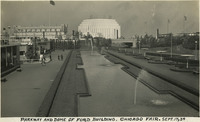 McCarthy Album 11, Photograph 271
McCarthy Album 11, Photograph 271 Caption: "Parkway and Dome of Ford Building. Chicago Fair. Sept. 17, 34." Several pedestrians wander along a parkway with a small lagoon and fountains, flanked by benches and manicured hedges. The Ford Building rises in the distance. The Exposition, a world fair attended by thirty-nine million people, celebrated Chicago's one-hundred year anniversary of incorporation. Originally planned to only run from May to November in 1933, it was such a success that its organizers decided to keep it running for a second season from May through October the following year. The central theme of the Exposition was technological innovation, with a motto of "Science Finds, Industry Applies, Man Conforms." None of the buildings constructed for the fair are still extant today, having been built as temporary facilities.
-
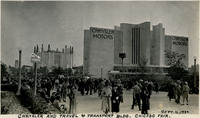 McCarthy Album 11, Photograph 270
McCarthy Album 11, Photograph 270 Caption: "Chrysler and Travel & Transport Bldg. Chicago Fair. Sept. 16, 1934." View of two buildings at the Century of Progress Exposition in Chicago. The Chrysler Motors building dominates the photograph, while the Travel and Transport Building can be seen at the left. The latter building featured a catenary roof, the first one built in the US. The Exposition, a world fair attended by thirty-nine million people, celebrated Chicago's one-hundred year anniversary of incorporation. Originally planned to only run from May to November in 1933, it was such a success that its organizers decided to keep it running for a second season from May through October the following year. The central theme of the Exposition was technological innovation, with a motto of "Science Finds, Industry Applies, Man Conforms." None of the buildings constructed for the fair are still extant today, having been built as temporary facilities.
-
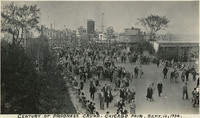 McCarthy Album 11, Photograph 269
McCarthy Album 11, Photograph 269 Caption: "Century of Progress Crowd. Chicago Fair. Sept. 16, 1934." A large crowd mills about on a wide thoroughfare in Chicago's Century of Progress Exposition. The Exposition, a world fair attended by thirty-nine million people, celebrated Chicago's one-hundred year anniversary of incorporation. Originally planned to only run from May to November in 1933, it was such a success that its organizers decided to keep it running for a second season from May through October the following year. The central theme of the Exposition was technological innovation, with a motto of "Science Finds, Industry Applies, Man Conforms." None of the buildings constructed for the fair are still extant today, having been built as temporary facilities.
-
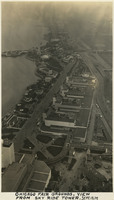 McCarthy Album 11, Photograph 268
McCarthy Album 11, Photograph 268 Caption: "Chicago Fair Grounds. View from Sky Ride Tower, Sept. 15, 34." Bird's eye view of the fair grounds where Chicago held its Century of Progress Exposition, a world fair celebrating the city's one-hundred year anniversary of incorporation. Originally planned to only run from May to November in 1933, it was such a success that its organizers decided to keep it running for a second season from May through October the following year. This photograph was taken from one of the two Sky Ride Towers, 628-foot structures that carried an aerial tram or gondola over the harbor in the center of the fair grounds. Over 4.5 million passengers enjoyed the views from the Sky Ride before it was demolished after the conclusion of the exposition in 1934.
-
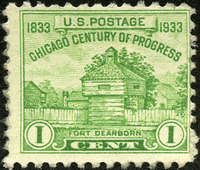 McCarthy Album 11, Photograph 267b
McCarthy Album 11, Photograph 267b No caption. Commemorative U.S. postage stamp issued in 1933 for Chicago's Century of Progress Exposition, celebrating the one-hundred year anniversary of Chicago's incorporation. This stamp features Fort Dearborn, a fort built in 1803 in what is now Chicago proper. While the original fort was destroyed during the War of 1812, and the second fort which replaced it was destroyed by fires in 1857 and 1871, a replica was constructed for the Exposition.
-
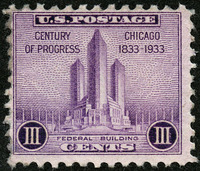 McCarthy Album 11, Photograph 267a
McCarthy Album 11, Photograph 267a No caption. Commemorative U.S. Postage stamp issued in 1933 for Chicago's Century of Progress Exposition, celebrating the one-hundred year anniversary of Chicago's incorporation. This stamp features the Exposition's Federal Building. Its three tall columns represent each branch of the federal government.
-
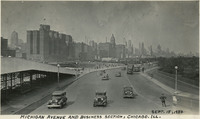 McCarthy Album 11, Photograph 267
McCarthy Album 11, Photograph 267 Caption: "Michigan Avenue and Business Section, Chicago. Ill. Sept. 15, 1934." View of a portion of Chicago's skyline from Michigan Avenue.
-
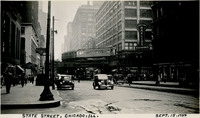 McCarthy Album 11, Photograph 266
McCarthy Album 11, Photograph 266 Caption: "State Street, Chicago, Ill. Sept. 15, 1934." Busy street scene in Chicago, featuring a view of a raised rail track for what appear to be passenger trains.
-
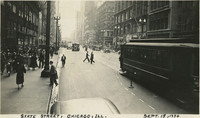 McCarthy Album 11, Photograph 265
McCarthy Album 11, Photograph 265 Caption: "State Street, Chicago, Ill. Sept. 15, 1934." Busy street scene in Chicago, with dozens of pedestrians, automobiles, and a street car or trolley.
-
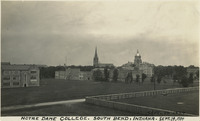 McCarthy Album 11, Photograph 264
McCarthy Album 11, Photograph 264 Caption: "Notre Dame College. South Bend, Indiana. Sept. 14, 1734 [sic], Sept. 14, 1934." Founded in 1842 and officially chartered in 1844, the University of Notre Dame is a Catholic research university famous world-wide for the quality of the education it provides. This photograph shows the Main Building's domed tower, (just to the right of center), and the steeple of the Basilica of the Sacred Heart (center), the university's on-site Catholic Church.
-
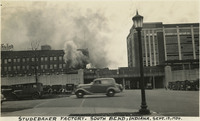 McCarthy Album 11, Photograph 263
McCarthy Album 11, Photograph 263 Caption: "Studebaker Factory. South Bend, Indiana. Sept. 13, 1934." Two buildings of the Studebaker Factory in South Bend are visible in this photograph. The Studebaker brothers started operations in South Bend in 1852, when they established a blacksmith shop and foundry. They soon began building wagons and carriages, demand for which soared with the advent of the Civil War and an increase in migration toward and into the American West. The company gradually phased out wagon production in favor of automobile manufacture in the early twentieth century. Sales declined after World War II, leading to the eventual closure of the factory in 1963.
-
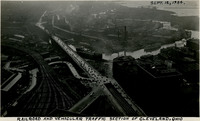 McCarthy Album 11, Photograph 262
McCarthy Album 11, Photograph 262 Caption: "Railroad and Vehicular Traffic Section of Cleveland, Ohio, Sept. 12, 1934." Bird's eye view of an industrial section of Cleveland, showing rail yard facilities and a busy highway.
-
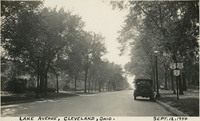 McCarthy Album 11, Photograph 261
McCarthy Album 11, Photograph 261 Caption: "Lake Avenue, Cleveland, Ohio. Sept. 12, 1934." Street scene along Cleveland's Lake Avenue. The roadway is lined by trees and grassy verges.
-
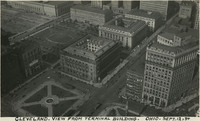 McCarthy Album 11, Photograph 260
McCarthy Album 11, Photograph 260 Caption: "Cleveland. View from Terminal Building. Ohio. Sept. 12, 34." Bird's eye view of a portion of Cleveland's downtown, as seen from the Terminal Tower.
-
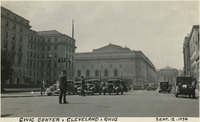 McCarthy Album 11, Photograph 259
McCarthy Album 11, Photograph 259 Caption: "Civic Center, Cleveland, Ohio, Sept. 12, 1934." View of a busy intersection in Cleveland's Civic Center, a district housing several governmental buildings.
-
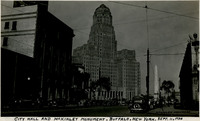 McCarthy Album 11, Photograph 258
McCarthy Album 11, Photograph 258 Caption: "City Hall and McKinley Monument. Buffalo, New York. Sept. 11, 1934, McKinley Monument." Buffalo's City Hall dominates this photograph. Designed by architect John Wade, the Art Deco-style building was completed in 1931. The white obelisk of McKinley Monument rises to the right of City Hall, commemorating William McKinley, 25th President of the US. He was shot while attending the World's Fair in Buffalo in 1901.
-
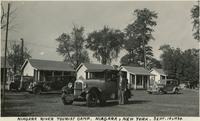 McCarthy Album 11, Photograph 257
McCarthy Album 11, Photograph 257 Caption: "Niagara River Tourist Camp. Niagara, New York. Sept. 10, 1934." William McCarthy standing next to an automobile in an early auto camp near Niagara Falls.
-
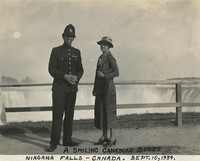 McCarthy Album 11, Photograph 256
McCarthy Album 11, Photograph 256 Caption: "A Smiling Canadian Bobby. Niagara Falls -- Canada. Sept. 10, 1934." Grace McCarthy posing with a Canadian police officer in front of Niagara Falls.
-
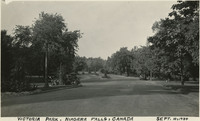 McCarthy Album 11, Photograph 255
McCarthy Album 11, Photograph 255 Caption: "Victoria Park. Niagara Falls, Canada, Sept. 10, 1934." Broad roadway flanked by manicured grounds and trees, running through Queen Victoria Park in Niagara Falls, Ontario, Canada. Opened in 1888, the park is operated today by the Niagara Parks Commission.
-
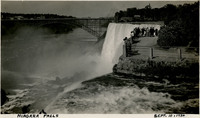 McCarthy Album 11, Photograph 254
McCarthy Album 11, Photograph 254 Caption: "Niagara Falls, Sept. 10, 1934." View of a portion of the iconic Niagara Falls straddling the border between Ontario, Canada, and the State of New York.
-
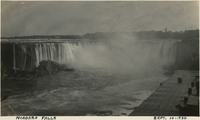 McCarthy Album 11, Photograph 253
McCarthy Album 11, Photograph 253 Caption: "Niagara Falls, Sept. 10, 1934." View of Horseshoe Falls, largest of the three waterfalls that make up the iconic Niagara Falls straddling the border between Ontario, Canada, and the State of New York.
-
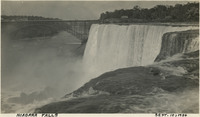 McCarthy Album 11, Photograph 252
McCarthy Album 11, Photograph 252 Caption: "Niagara Falls, Sept. 10, 1934." View of a portion of the iconic Niagara Falls straddling the border between Ontario, Canada, and the State of New York.
-
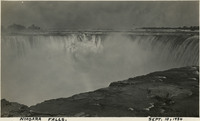 McCarthy Album 11, Photograph 251
McCarthy Album 11, Photograph 251 Caption: "Niagara Falls. Sept. 10, 1934." View of Horseshoe Falls, largest of the three waterfalls that make up the iconic Niagara Falls straddling the border between Ontario, Canada, and the State of New York.
-
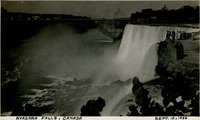 McCarthy Album 11, Photograph 250
McCarthy Album 11, Photograph 250 Caption: "Niagara Falls, Canada, Sept. 10, 1934." View of a portion of the iconic Niagara Falls straddling the border between Ontario, Canada, and the State of New York.
-
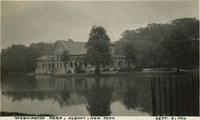 McCarthy Album 11, Photograph 249
McCarthy Album 11, Photograph 249 Caption: "Washington Park, Albany, New York, Sept. 8, 1934." Albany's Washington Park was established in the early 1870s. Washington Park Lake, a portion of which is seen in this photograph, was created by damming Beaverkill Creek in 1873. The Lake House in the photograph was constructed in 1929, replacing an earlier building.
-
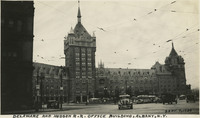 McCarthy Album 11, Photograph 248
McCarthy Album 11, Photograph 248 Caption: "Delaware and Hudson R.R. Office Building, Albany, N.Y., Sept. 7, 1934." View of the enormous Gothic building constructed by and for the Delaware and Hudson Railroad Company between 1914-1918. It also housed the offices of the Albany Evening Journal. A small city park sits in front of the building's central tower, surrounded on all sides by a looped street originally intended for trolley cars. The building was gradually abandoned by the businesses within, until purchased in 1973 by the State University of New York (SUNY). SUNY renovated the building for use as its administrative offices, a purpose which it still serves today.
-
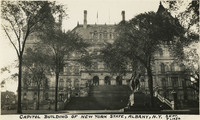 McCarthy Album 11, Photograph 247
McCarthy Album 11, Photograph 247 Caption: "Capitol Building of New York State, Albany, N.Y., Sept. 7, 1934." New York State's Capitol Building was constructed between 1867 and 1899. The initial architect, Thomas Fuller, designed the first floor in a Classical or Romanesque style. He was replaced by Leopold Eidlitz and Henry Hobson Richardson, who designed the next two floors in a Renaissance style. The final architect to preside over the project was Isaac G. Perry, who completed the building in a Victorian-Romanesque style. The building was listed on the National Register of Historic Places in 1971, and declared a National Historic Landmark in 1979.
-
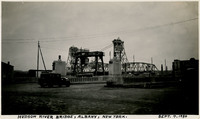 McCarthy Album 11, Photograph 246
McCarthy Album 11, Photograph 246 Caption: "Hudson River Bridge, Albany, New York. Sept. 7, 1934." View of an automobile bridge in the foreground, with a concrete deck, and what appears to be a railroad bridge, possibly of the bascule or swing type, in the background.
-
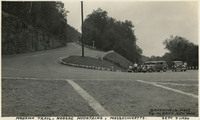 McCarthy Album 11, Photograph 245
McCarthy Album 11, Photograph 245 Caption: "Mohawk Trail, Hoosac Mountains, Massachusetts. Greenfield Mass to Albany New York, Sept 7, 1934." Hairpin turn on the Mohawk Trail, a scenic highway in Massachusetts. The Trail, originally a trade route for Native American tribes, was adopted as the route for the first scenic road constructed in the state. A gravel road was built along the route between 1912 and 1914, and later expanded as automobile traffic increased nation-wide. It is now part of Massachusetts Route 2.
-
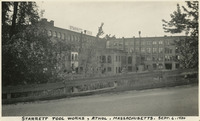 McCarthy Album 11, Photograph 244
McCarthy Album 11, Photograph 244 Caption: "Starrett Tool Works, Athol, Massachusetts. Sept. 6, 1934." The Starrett Tool Works was founded in 1880, when Laroy Sunderland Starrett started a tool shop in Athol. He later expanded the facility, until by 1906 the company employed more than 1,000 workers in the manufacture of precision tools. By the time Starrett died in 1922, the company had achieved global recognition, establishing offices in more than a dozen countries. Starrett is still in operation today.
-
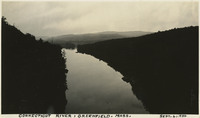 McCarthy Album 11, Photograph 243
McCarthy Album 11, Photograph 243 Caption: "Connecticut River, Greenfield. Mass. Sept. 6, 1934." Picturesque view of the Connecticut River, flanked by rolling hills and mirroring the clouds in the sky above.
-
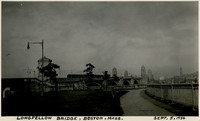 McCarthy Album 11, Photograph 242
McCarthy Album 11, Photograph 242 Caption: "Longfellow Bridge, Boston, Mass. Sept. 5, 1934." The Longfellow Bridge spans the Charles River between Boston and Cambridge. Originally called the Cambridge Bridge, it replaced a wood structure called the West Boston Bridge that had been constructed in 1793. This wood bridge was unable to handle large volumes of traffic or the introduction of street cars, so a new bridge was built in the early twentieth century. Opened in 1906 as the Cambridge Bridge, the name was changed in 1927 to the Longfellow Bridge in honor of poet Henry Wadsworth Longfellow. It is colloquially known as the Salt and Pepper Bridge, as its central towers are reminiscent in shape of salt and pepper shakers.
-
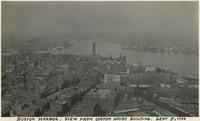 McCarthy Album 11, Photograph 241
McCarthy Album 11, Photograph 241 Caption: "Boston Harbor. View from Custom House Building. Sept 5, 1934." Bird's eye view of Boston Harbor and surrounding port and wharf facilities.
-
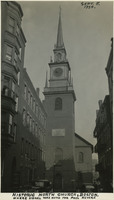 McCarthy Album 11, Photograph 240
McCarthy Album 11, Photograph 240 Caption: "Historic North Church, Boston. Where Signal was Hung for Paul Revere, Sept. 5, 1934." View of the clock tower and steeple of the Old North Church, built in 1723. The church is said to be the site where Paul Revere, after his famous midnight ride, caused two lanterns to be hung as the signal that British troops were advancing into the area by sea rather than by land.
-
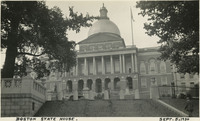 McCarthy Album 11, Photograph 239
McCarthy Album 11, Photograph 239 Caption: "Boston State House. Sept. 5, 1934." The Massachusetts State House has been the seat of government for the Commonwealth of Massachusetts since its completion in 1798. Designed by Charles Bullfinch, its prominent feature is its gold-leafed dome. The building, a significant example of Federal architecture in a civic structure, has been declared a National Historic Landmark.
-
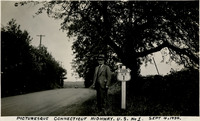 McCarthy Album 11, Photograph 238
McCarthy Album 11, Photograph 238 Caption: "Picturesque Connecticut Highway. U.S. No 1. Sept. 4, 1934." William McCarthy standing next to a U.S. Route 1 sign along a tree-lined highway. U.S. Route 1 is a north-south highway connecting the eastern seaboard from Fort Kent, Maine to Key West, Florida.
-
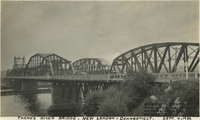 McCarthy Album 11, Photograph 237
McCarthy Album 11, Photograph 237 Caption: "Thames River Bridge, New London, Connecticut. Where Harvard and Yale Hold their Annual Rowing Regatta, Sept. 4, 1934." View of two bridges over the Thames River near New London, Connecticut. The drawbridge in the foreground was originally a railroad bridge, built in the late nineteenth century. Later, as automobiles grew in popularity, this bridge was converted to use by vehicles (cars can be seen driving over it in this photograph), and a second bridge was constructed for railroad use (a locomotive can be seen behind the two cars). Neither of these bridges survives today, having been replaced by the Gold Star Memorial Bridge.
-
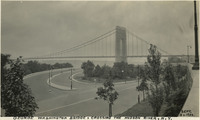 McCarthy Album 11, Photograph 236
McCarthy Album 11, Photograph 236 Caption: "George Washington Bridge, Crossing the Hudson River, N.Y. Sept. 3, 1934." This suspension bridge, designed by Othmar Ammann, spans the Hudson River between Manhattan in New York City, and Fort Lee, New Jersey. Constructed between 1927 and 1931, the bridge included the longest main span in the world at the time, a record it held until construction of the Golden Gate Bridge was completed in 1937. It was originally built with only one deck (as seen in this photograph), but a second deck opened in 1962. Still in active use today, it carried over 51 million vehicles in 2016.
-
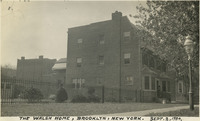 McCarthy Album 11, Photograph 235
McCarthy Album 11, Photograph 235 Caption: "The Walsh Home, Brooklyn, New York. Sept. 2, 1934." View of a three-story brick house or apartment building, with a park or empty lot on one side. See also 96-07-08-alb09-202.
 McCarthy Album 11, Photograph 282 Caption: "Sept. 20, 1934, The Big Studebaker Theatre. Capacity 80 People. Chicago Fair." This giant replica of a 1934 Studebaker Land Cruiser at the Century of Progress Exposition, made of plaster over a wood frame, sat above a small theater capable of sitting eighty people. The Exposition, a world fair attended by thirty-nine million people, celebrated Chicago's one-hundred year anniversary of incorporation. Originally planned to only run from May to November in 1933, it was such a success that its organizers decided to keep it running for a second season from May through October the following year. The central theme of the Exposition was technological innovation, with a motto of "Science Finds, Industry Applies, Man Conforms."
McCarthy Album 11, Photograph 282 Caption: "Sept. 20, 1934, The Big Studebaker Theatre. Capacity 80 People. Chicago Fair." This giant replica of a 1934 Studebaker Land Cruiser at the Century of Progress Exposition, made of plaster over a wood frame, sat above a small theater capable of sitting eighty people. The Exposition, a world fair attended by thirty-nine million people, celebrated Chicago's one-hundred year anniversary of incorporation. Originally planned to only run from May to November in 1933, it was such a success that its organizers decided to keep it running for a second season from May through October the following year. The central theme of the Exposition was technological innovation, with a motto of "Science Finds, Industry Applies, Man Conforms." McCarthy Album 11, Photograph 281 Caption: "Frank Bucks [sic] Monkey Land. Chicago Fair. Sept. 20, 1934." View of a rocky cliff populated by a species of monkey. This was part of a display at Frank Buck's Jungle Camp, an exhibition at Chicago's Century of Progress Exposition. The Exposition, a world fair attended by thirty-nine million people, celebrated Chicago's one-hundred year anniversary of incorporation. Originally planned to only run from May to November in 1933, it was such a success that its organizers decided to keep it running for a second season from May through October the following year. The central theme of the Exposition was technological innovation, with a motto of "Science Finds, Industry Applies, Man Conforms."
McCarthy Album 11, Photograph 281 Caption: "Frank Bucks [sic] Monkey Land. Chicago Fair. Sept. 20, 1934." View of a rocky cliff populated by a species of monkey. This was part of a display at Frank Buck's Jungle Camp, an exhibition at Chicago's Century of Progress Exposition. The Exposition, a world fair attended by thirty-nine million people, celebrated Chicago's one-hundred year anniversary of incorporation. Originally planned to only run from May to November in 1933, it was such a success that its organizers decided to keep it running for a second season from May through October the following year. The central theme of the Exposition was technological innovation, with a motto of "Science Finds, Industry Applies, Man Conforms." McCarthy Album 11, Photograph 280 Caption: "U.S. 3 Inch Antiaircraft [sic] Gun. Chicago Fair. Sept, [sic] 19, 1934." View of a 3"/50 caliber anti-aircraft gun, a heavy artillery weapon used by the US Navy and Coast Guard. The weapon was part of a display at Chicago's Century of Progress Exposition. The Exposition, a world fair attended by thirty-nine million people, celebrated Chicago's one-hundred year anniversary of incorporation. Originally planned to only run from May to November in 1933, it was such a success that its organizers decided to keep it running for a second season from May through October the following year. The central theme of the Exposition was technological innovation, with a motto of "Science Finds, Industry Applies, Man Conforms."
McCarthy Album 11, Photograph 280 Caption: "U.S. 3 Inch Antiaircraft [sic] Gun. Chicago Fair. Sept, [sic] 19, 1934." View of a 3"/50 caliber anti-aircraft gun, a heavy artillery weapon used by the US Navy and Coast Guard. The weapon was part of a display at Chicago's Century of Progress Exposition. The Exposition, a world fair attended by thirty-nine million people, celebrated Chicago's one-hundred year anniversary of incorporation. Originally planned to only run from May to November in 1933, it was such a success that its organizers decided to keep it running for a second season from May through October the following year. The central theme of the Exposition was technological innovation, with a motto of "Science Finds, Industry Applies, Man Conforms." McCarthy Album 11, Photograph 279 Caption: "Henry Ford's First Automobile and Machine Shop, Chicago Fair Exhibit. Sept. 19, 1934." This exhibit within the Ford Building at Chicago's Century of Progress Exposition replicated Henry Ford's original workshop, including a Quadricycle, the first automobile produced by Ford. The Exposition, a world fair attended by thirty-nine million people, celebrated Chicago's one-hundred year anniversary of incorporation. Originally planned to only run from May to November in 1933, it was such a success that its organizers decided to keep it running for a second season from May through October the following year. The central theme of the Exposition was technological innovation, with a motto of "Science Finds, Industry Applies, Man Conforms."
McCarthy Album 11, Photograph 279 Caption: "Henry Ford's First Automobile and Machine Shop, Chicago Fair Exhibit. Sept. 19, 1934." This exhibit within the Ford Building at Chicago's Century of Progress Exposition replicated Henry Ford's original workshop, including a Quadricycle, the first automobile produced by Ford. The Exposition, a world fair attended by thirty-nine million people, celebrated Chicago's one-hundred year anniversary of incorporation. Originally planned to only run from May to November in 1933, it was such a success that its organizers decided to keep it running for a second season from May through October the following year. The central theme of the Exposition was technological innovation, with a motto of "Science Finds, Industry Applies, Man Conforms." McCarthy Album 11, Photograph 278 Caption: "The Lagoon with the Sky Ride in the distance. Chicago Fair. Sept. 18, 1934." Dominating this photograph is one of the 628-foot towers making up the Sky Ride, an aerial tramway which carried fair goers in small gondolas or trams (visible just to the left of the tower) over the harbor around which the Century of Progress Exposition was held. Over 4.5 million passengers enjoyed the views from the Sky Ride before it was demolished after the conclusion of the exposition in 1934. The Exposition, a world fair attended by thirty-nine million people, celebrated Chicago's one-hundred year anniversary of incorporation. Originally planned to only run from May to November in 1933, it was such a success that its organizers decided to keep it running for a second season from May through October the following year. The central theme of the Exposition was technological innovation, with a motto of "Science Finds, Industry Applies, Man Conforms."
McCarthy Album 11, Photograph 278 Caption: "The Lagoon with the Sky Ride in the distance. Chicago Fair. Sept. 18, 1934." Dominating this photograph is one of the 628-foot towers making up the Sky Ride, an aerial tramway which carried fair goers in small gondolas or trams (visible just to the left of the tower) over the harbor around which the Century of Progress Exposition was held. Over 4.5 million passengers enjoyed the views from the Sky Ride before it was demolished after the conclusion of the exposition in 1934. The Exposition, a world fair attended by thirty-nine million people, celebrated Chicago's one-hundred year anniversary of incorporation. Originally planned to only run from May to November in 1933, it was such a success that its organizers decided to keep it running for a second season from May through October the following year. The central theme of the Exposition was technological innovation, with a motto of "Science Finds, Industry Applies, Man Conforms." McCarthy Album 11, Photograph 277 Caption: "Government Building. Chicago Fair. Sept. 18, 1934." View of the Federal Building at Chicago's Century of Progress Exposition, as seen from across the harbor. The three tall towers represent the three branches of the federal government. This building, towering over the Exposition, was featured on a commemorative US Postage Stamp issued in honor of the Exposition. A world fair attended by thirty-nine million people, the Expo celebrated Chicago's one-hundred year anniversary of incorporation. Originally planned to only run from May to November in 1933, it was such a success that its organizers decided to keep it running for a second season from May through October the following year. The central theme of the Exposition was technological innovation, with a motto of "Science Finds, Industry Applies, Man Conforms."
McCarthy Album 11, Photograph 277 Caption: "Government Building. Chicago Fair. Sept. 18, 1934." View of the Federal Building at Chicago's Century of Progress Exposition, as seen from across the harbor. The three tall towers represent the three branches of the federal government. This building, towering over the Exposition, was featured on a commemorative US Postage Stamp issued in honor of the Exposition. A world fair attended by thirty-nine million people, the Expo celebrated Chicago's one-hundred year anniversary of incorporation. Originally planned to only run from May to November in 1933, it was such a success that its organizers decided to keep it running for a second season from May through October the following year. The central theme of the Exposition was technological innovation, with a motto of "Science Finds, Industry Applies, Man Conforms." McCarthy Album 11, Photograph 276 Caption: "Garden at American Radiator Co. Exhibit. Chicago [sic] Fair. Sept. 18, 1934." William McCarthy stands in front of a series of pools cascading into one another, surrounded by manicured plants at the Century of Progress Exposition. The Exposition, a world fair attended by thirty-nine million people, celebrated Chicago's one-hundred year anniversary of incorporation. Originally planned to only run from May to November in 1933, it was such a success that its organizers decided to keep it running for a second season from May through October the following year. The central theme of the Exposition was technological innovation, with a motto of "Science Finds, Industry Applies, Man Conforms."
McCarthy Album 11, Photograph 276 Caption: "Garden at American Radiator Co. Exhibit. Chicago [sic] Fair. Sept. 18, 1934." William McCarthy stands in front of a series of pools cascading into one another, surrounded by manicured plants at the Century of Progress Exposition. The Exposition, a world fair attended by thirty-nine million people, celebrated Chicago's one-hundred year anniversary of incorporation. Originally planned to only run from May to November in 1933, it was such a success that its organizers decided to keep it running for a second season from May through October the following year. The central theme of the Exposition was technological innovation, with a motto of "Science Finds, Industry Applies, Man Conforms." McCarthy Album 11, Photograph 275 Caption: "Sky Ride Across Lagoon. View from Swifts Music Stand. Chicago Fair, Sept. 18, 1934." One of the 628-foot towers making up the Sky Ride, an aerial tramway which carried fair goers in small gondolas or trams (visible in the center of the photograph) over the harbor around which the Century of Progress Exposition was held. Over 4.5 million passengers enjoyed the views from the Sky Ride before it was demolished after the conclusion of the exposition in 1934. The Exposition, a world fair attended by thirty-nine million people, celebrated Chicago's one-hundred year anniversary of incorporation. Originally planned to only run from May to November in 1933, it was such a success that its organizers decided to keep it running for a second season from May through October the following year. The central theme of the Exposition was technological innovation, with a motto of "Science Finds, Industry Applies, Man Conforms."
McCarthy Album 11, Photograph 275 Caption: "Sky Ride Across Lagoon. View from Swifts Music Stand. Chicago Fair, Sept. 18, 1934." One of the 628-foot towers making up the Sky Ride, an aerial tramway which carried fair goers in small gondolas or trams (visible in the center of the photograph) over the harbor around which the Century of Progress Exposition was held. Over 4.5 million passengers enjoyed the views from the Sky Ride before it was demolished after the conclusion of the exposition in 1934. The Exposition, a world fair attended by thirty-nine million people, celebrated Chicago's one-hundred year anniversary of incorporation. Originally planned to only run from May to November in 1933, it was such a success that its organizers decided to keep it running for a second season from May through October the following year. The central theme of the Exposition was technological innovation, with a motto of "Science Finds, Industry Applies, Man Conforms." McCarthy Album 11, Photograph 274 Caption: "Crowd Watching Chrysler Automobile Maneuvers. Chicago Fair. Sept. 17, 1934." Fairgoers pack the stands at a demonstration of the capabilities of Chrysler automobiles on a track created as part of the Chrysler complex built for the Exposition. The Exposition, a world fair attended by thirty-nine million people, celebrated Chicago's one-hundred year anniversary of incorporation. Originally planned to only run from May to November in 1933, it was such a success that its organizers decided to keep it running for a second season from May through October the following year. The central theme of the Exposition was technological innovation, with a motto of "Science Finds, Industry Applies, Man Conforms."
McCarthy Album 11, Photograph 274 Caption: "Crowd Watching Chrysler Automobile Maneuvers. Chicago Fair. Sept. 17, 1934." Fairgoers pack the stands at a demonstration of the capabilities of Chrysler automobiles on a track created as part of the Chrysler complex built for the Exposition. The Exposition, a world fair attended by thirty-nine million people, celebrated Chicago's one-hundred year anniversary of incorporation. Originally planned to only run from May to November in 1933, it was such a success that its organizers decided to keep it running for a second season from May through October the following year. The central theme of the Exposition was technological innovation, with a motto of "Science Finds, Industry Applies, Man Conforms." McCarthy Album 11, Photograph 273 Caption: "Chicago Fair Grounds, View of Lagoon from Sky Ride. No 1 Agricultural Building. No2 Government Building. Sept. 17, 1934." Bird's eye view of a portion of the fair grounds for Chicago's Century of Progress Exposition. Two of the fair's structures have been labeled in this photograph, including the Agriculture Building, a long low structure, and the Federal Building, featuring three towers representing the three branches of the federal government. The Exposition, a world fair attended by thirty-nine million people, celebrated Chicago's one-hundred year anniversary of incorporation. Originally planned to only run from May to November in 1933, it was such a success that its organizers decided to keep it running for a second season from May through October the following year. The central theme of the Exposition was technological innovation, with a motto of "Science Finds, Industry Applies, Man Conforms." None of the buildings constructed for the fair are still extant today, having been built as temporary facilities.
McCarthy Album 11, Photograph 273 Caption: "Chicago Fair Grounds, View of Lagoon from Sky Ride. No 1 Agricultural Building. No2 Government Building. Sept. 17, 1934." Bird's eye view of a portion of the fair grounds for Chicago's Century of Progress Exposition. Two of the fair's structures have been labeled in this photograph, including the Agriculture Building, a long low structure, and the Federal Building, featuring three towers representing the three branches of the federal government. The Exposition, a world fair attended by thirty-nine million people, celebrated Chicago's one-hundred year anniversary of incorporation. Originally planned to only run from May to November in 1933, it was such a success that its organizers decided to keep it running for a second season from May through October the following year. The central theme of the Exposition was technological innovation, with a motto of "Science Finds, Industry Applies, Man Conforms." None of the buildings constructed for the fair are still extant today, having been built as temporary facilities. McCarthy Album 11, Photograph 272 Caption: "General Motors Building, Chicago Fair. Sept. 17, 1934." Grace McCarthy stands at a railing with the General Motors Building in the background. The building was part of the Century of Progress Exposition, a world fair attended by thirty-nine million people, celebrated Chicago's one-hundred year anniversary of incorporation. Originally planned to only run from May to November in 1933, it was such a success that its organizers decided to keep it running for a second season from May through October the following year. The central theme of the Exposition was technological innovation, with a motto of "Science Finds, Industry Applies, Man Conforms." None of the buildings constructed for the fair are still extant today, having been built as temporary facilities.
McCarthy Album 11, Photograph 272 Caption: "General Motors Building, Chicago Fair. Sept. 17, 1934." Grace McCarthy stands at a railing with the General Motors Building in the background. The building was part of the Century of Progress Exposition, a world fair attended by thirty-nine million people, celebrated Chicago's one-hundred year anniversary of incorporation. Originally planned to only run from May to November in 1933, it was such a success that its organizers decided to keep it running for a second season from May through October the following year. The central theme of the Exposition was technological innovation, with a motto of "Science Finds, Industry Applies, Man Conforms." None of the buildings constructed for the fair are still extant today, having been built as temporary facilities. McCarthy Album 11, Photograph 271 Caption: "Parkway and Dome of Ford Building. Chicago Fair. Sept. 17, 34." Several pedestrians wander along a parkway with a small lagoon and fountains, flanked by benches and manicured hedges. The Ford Building rises in the distance. The Exposition, a world fair attended by thirty-nine million people, celebrated Chicago's one-hundred year anniversary of incorporation. Originally planned to only run from May to November in 1933, it was such a success that its organizers decided to keep it running for a second season from May through October the following year. The central theme of the Exposition was technological innovation, with a motto of "Science Finds, Industry Applies, Man Conforms." None of the buildings constructed for the fair are still extant today, having been built as temporary facilities.
McCarthy Album 11, Photograph 271 Caption: "Parkway and Dome of Ford Building. Chicago Fair. Sept. 17, 34." Several pedestrians wander along a parkway with a small lagoon and fountains, flanked by benches and manicured hedges. The Ford Building rises in the distance. The Exposition, a world fair attended by thirty-nine million people, celebrated Chicago's one-hundred year anniversary of incorporation. Originally planned to only run from May to November in 1933, it was such a success that its organizers decided to keep it running for a second season from May through October the following year. The central theme of the Exposition was technological innovation, with a motto of "Science Finds, Industry Applies, Man Conforms." None of the buildings constructed for the fair are still extant today, having been built as temporary facilities. McCarthy Album 11, Photograph 270 Caption: "Chrysler and Travel & Transport Bldg. Chicago Fair. Sept. 16, 1934." View of two buildings at the Century of Progress Exposition in Chicago. The Chrysler Motors building dominates the photograph, while the Travel and Transport Building can be seen at the left. The latter building featured a catenary roof, the first one built in the US. The Exposition, a world fair attended by thirty-nine million people, celebrated Chicago's one-hundred year anniversary of incorporation. Originally planned to only run from May to November in 1933, it was such a success that its organizers decided to keep it running for a second season from May through October the following year. The central theme of the Exposition was technological innovation, with a motto of "Science Finds, Industry Applies, Man Conforms." None of the buildings constructed for the fair are still extant today, having been built as temporary facilities.
McCarthy Album 11, Photograph 270 Caption: "Chrysler and Travel & Transport Bldg. Chicago Fair. Sept. 16, 1934." View of two buildings at the Century of Progress Exposition in Chicago. The Chrysler Motors building dominates the photograph, while the Travel and Transport Building can be seen at the left. The latter building featured a catenary roof, the first one built in the US. The Exposition, a world fair attended by thirty-nine million people, celebrated Chicago's one-hundred year anniversary of incorporation. Originally planned to only run from May to November in 1933, it was such a success that its organizers decided to keep it running for a second season from May through October the following year. The central theme of the Exposition was technological innovation, with a motto of "Science Finds, Industry Applies, Man Conforms." None of the buildings constructed for the fair are still extant today, having been built as temporary facilities. McCarthy Album 11, Photograph 269 Caption: "Century of Progress Crowd. Chicago Fair. Sept. 16, 1934." A large crowd mills about on a wide thoroughfare in Chicago's Century of Progress Exposition. The Exposition, a world fair attended by thirty-nine million people, celebrated Chicago's one-hundred year anniversary of incorporation. Originally planned to only run from May to November in 1933, it was such a success that its organizers decided to keep it running for a second season from May through October the following year. The central theme of the Exposition was technological innovation, with a motto of "Science Finds, Industry Applies, Man Conforms." None of the buildings constructed for the fair are still extant today, having been built as temporary facilities.
McCarthy Album 11, Photograph 269 Caption: "Century of Progress Crowd. Chicago Fair. Sept. 16, 1934." A large crowd mills about on a wide thoroughfare in Chicago's Century of Progress Exposition. The Exposition, a world fair attended by thirty-nine million people, celebrated Chicago's one-hundred year anniversary of incorporation. Originally planned to only run from May to November in 1933, it was such a success that its organizers decided to keep it running for a second season from May through October the following year. The central theme of the Exposition was technological innovation, with a motto of "Science Finds, Industry Applies, Man Conforms." None of the buildings constructed for the fair are still extant today, having been built as temporary facilities. McCarthy Album 11, Photograph 268 Caption: "Chicago Fair Grounds. View from Sky Ride Tower, Sept. 15, 34." Bird's eye view of the fair grounds where Chicago held its Century of Progress Exposition, a world fair celebrating the city's one-hundred year anniversary of incorporation. Originally planned to only run from May to November in 1933, it was such a success that its organizers decided to keep it running for a second season from May through October the following year. This photograph was taken from one of the two Sky Ride Towers, 628-foot structures that carried an aerial tram or gondola over the harbor in the center of the fair grounds. Over 4.5 million passengers enjoyed the views from the Sky Ride before it was demolished after the conclusion of the exposition in 1934.
McCarthy Album 11, Photograph 268 Caption: "Chicago Fair Grounds. View from Sky Ride Tower, Sept. 15, 34." Bird's eye view of the fair grounds where Chicago held its Century of Progress Exposition, a world fair celebrating the city's one-hundred year anniversary of incorporation. Originally planned to only run from May to November in 1933, it was such a success that its organizers decided to keep it running for a second season from May through October the following year. This photograph was taken from one of the two Sky Ride Towers, 628-foot structures that carried an aerial tram or gondola over the harbor in the center of the fair grounds. Over 4.5 million passengers enjoyed the views from the Sky Ride before it was demolished after the conclusion of the exposition in 1934. McCarthy Album 11, Photograph 267b No caption. Commemorative U.S. postage stamp issued in 1933 for Chicago's Century of Progress Exposition, celebrating the one-hundred year anniversary of Chicago's incorporation. This stamp features Fort Dearborn, a fort built in 1803 in what is now Chicago proper. While the original fort was destroyed during the War of 1812, and the second fort which replaced it was destroyed by fires in 1857 and 1871, a replica was constructed for the Exposition.
McCarthy Album 11, Photograph 267b No caption. Commemorative U.S. postage stamp issued in 1933 for Chicago's Century of Progress Exposition, celebrating the one-hundred year anniversary of Chicago's incorporation. This stamp features Fort Dearborn, a fort built in 1803 in what is now Chicago proper. While the original fort was destroyed during the War of 1812, and the second fort which replaced it was destroyed by fires in 1857 and 1871, a replica was constructed for the Exposition. McCarthy Album 11, Photograph 267a No caption. Commemorative U.S. Postage stamp issued in 1933 for Chicago's Century of Progress Exposition, celebrating the one-hundred year anniversary of Chicago's incorporation. This stamp features the Exposition's Federal Building. Its three tall columns represent each branch of the federal government.
McCarthy Album 11, Photograph 267a No caption. Commemorative U.S. Postage stamp issued in 1933 for Chicago's Century of Progress Exposition, celebrating the one-hundred year anniversary of Chicago's incorporation. This stamp features the Exposition's Federal Building. Its three tall columns represent each branch of the federal government. McCarthy Album 11, Photograph 267 Caption: "Michigan Avenue and Business Section, Chicago. Ill. Sept. 15, 1934." View of a portion of Chicago's skyline from Michigan Avenue.
McCarthy Album 11, Photograph 267 Caption: "Michigan Avenue and Business Section, Chicago. Ill. Sept. 15, 1934." View of a portion of Chicago's skyline from Michigan Avenue. McCarthy Album 11, Photograph 266 Caption: "State Street, Chicago, Ill. Sept. 15, 1934." Busy street scene in Chicago, featuring a view of a raised rail track for what appear to be passenger trains.
McCarthy Album 11, Photograph 266 Caption: "State Street, Chicago, Ill. Sept. 15, 1934." Busy street scene in Chicago, featuring a view of a raised rail track for what appear to be passenger trains. McCarthy Album 11, Photograph 265 Caption: "State Street, Chicago, Ill. Sept. 15, 1934." Busy street scene in Chicago, with dozens of pedestrians, automobiles, and a street car or trolley.
McCarthy Album 11, Photograph 265 Caption: "State Street, Chicago, Ill. Sept. 15, 1934." Busy street scene in Chicago, with dozens of pedestrians, automobiles, and a street car or trolley. McCarthy Album 11, Photograph 264 Caption: "Notre Dame College. South Bend, Indiana. Sept. 14, 1734 [sic], Sept. 14, 1934." Founded in 1842 and officially chartered in 1844, the University of Notre Dame is a Catholic research university famous world-wide for the quality of the education it provides. This photograph shows the Main Building's domed tower, (just to the right of center), and the steeple of the Basilica of the Sacred Heart (center), the university's on-site Catholic Church.
McCarthy Album 11, Photograph 264 Caption: "Notre Dame College. South Bend, Indiana. Sept. 14, 1734 [sic], Sept. 14, 1934." Founded in 1842 and officially chartered in 1844, the University of Notre Dame is a Catholic research university famous world-wide for the quality of the education it provides. This photograph shows the Main Building's domed tower, (just to the right of center), and the steeple of the Basilica of the Sacred Heart (center), the university's on-site Catholic Church. McCarthy Album 11, Photograph 263 Caption: "Studebaker Factory. South Bend, Indiana. Sept. 13, 1934." Two buildings of the Studebaker Factory in South Bend are visible in this photograph. The Studebaker brothers started operations in South Bend in 1852, when they established a blacksmith shop and foundry. They soon began building wagons and carriages, demand for which soared with the advent of the Civil War and an increase in migration toward and into the American West. The company gradually phased out wagon production in favor of automobile manufacture in the early twentieth century. Sales declined after World War II, leading to the eventual closure of the factory in 1963.
McCarthy Album 11, Photograph 263 Caption: "Studebaker Factory. South Bend, Indiana. Sept. 13, 1934." Two buildings of the Studebaker Factory in South Bend are visible in this photograph. The Studebaker brothers started operations in South Bend in 1852, when they established a blacksmith shop and foundry. They soon began building wagons and carriages, demand for which soared with the advent of the Civil War and an increase in migration toward and into the American West. The company gradually phased out wagon production in favor of automobile manufacture in the early twentieth century. Sales declined after World War II, leading to the eventual closure of the factory in 1963. McCarthy Album 11, Photograph 262 Caption: "Railroad and Vehicular Traffic Section of Cleveland, Ohio, Sept. 12, 1934." Bird's eye view of an industrial section of Cleveland, showing rail yard facilities and a busy highway.
McCarthy Album 11, Photograph 262 Caption: "Railroad and Vehicular Traffic Section of Cleveland, Ohio, Sept. 12, 1934." Bird's eye view of an industrial section of Cleveland, showing rail yard facilities and a busy highway. McCarthy Album 11, Photograph 261 Caption: "Lake Avenue, Cleveland, Ohio. Sept. 12, 1934." Street scene along Cleveland's Lake Avenue. The roadway is lined by trees and grassy verges.
McCarthy Album 11, Photograph 261 Caption: "Lake Avenue, Cleveland, Ohio. Sept. 12, 1934." Street scene along Cleveland's Lake Avenue. The roadway is lined by trees and grassy verges. McCarthy Album 11, Photograph 260 Caption: "Cleveland. View from Terminal Building. Ohio. Sept. 12, 34." Bird's eye view of a portion of Cleveland's downtown, as seen from the Terminal Tower.
McCarthy Album 11, Photograph 260 Caption: "Cleveland. View from Terminal Building. Ohio. Sept. 12, 34." Bird's eye view of a portion of Cleveland's downtown, as seen from the Terminal Tower. McCarthy Album 11, Photograph 259 Caption: "Civic Center, Cleveland, Ohio, Sept. 12, 1934." View of a busy intersection in Cleveland's Civic Center, a district housing several governmental buildings.
McCarthy Album 11, Photograph 259 Caption: "Civic Center, Cleveland, Ohio, Sept. 12, 1934." View of a busy intersection in Cleveland's Civic Center, a district housing several governmental buildings. McCarthy Album 11, Photograph 258 Caption: "City Hall and McKinley Monument. Buffalo, New York. Sept. 11, 1934, McKinley Monument." Buffalo's City Hall dominates this photograph. Designed by architect John Wade, the Art Deco-style building was completed in 1931. The white obelisk of McKinley Monument rises to the right of City Hall, commemorating William McKinley, 25th President of the US. He was shot while attending the World's Fair in Buffalo in 1901.
McCarthy Album 11, Photograph 258 Caption: "City Hall and McKinley Monument. Buffalo, New York. Sept. 11, 1934, McKinley Monument." Buffalo's City Hall dominates this photograph. Designed by architect John Wade, the Art Deco-style building was completed in 1931. The white obelisk of McKinley Monument rises to the right of City Hall, commemorating William McKinley, 25th President of the US. He was shot while attending the World's Fair in Buffalo in 1901. McCarthy Album 11, Photograph 257 Caption: "Niagara River Tourist Camp. Niagara, New York. Sept. 10, 1934." William McCarthy standing next to an automobile in an early auto camp near Niagara Falls.
McCarthy Album 11, Photograph 257 Caption: "Niagara River Tourist Camp. Niagara, New York. Sept. 10, 1934." William McCarthy standing next to an automobile in an early auto camp near Niagara Falls. McCarthy Album 11, Photograph 256 Caption: "A Smiling Canadian Bobby. Niagara Falls -- Canada. Sept. 10, 1934." Grace McCarthy posing with a Canadian police officer in front of Niagara Falls.
McCarthy Album 11, Photograph 256 Caption: "A Smiling Canadian Bobby. Niagara Falls -- Canada. Sept. 10, 1934." Grace McCarthy posing with a Canadian police officer in front of Niagara Falls. McCarthy Album 11, Photograph 255 Caption: "Victoria Park. Niagara Falls, Canada, Sept. 10, 1934." Broad roadway flanked by manicured grounds and trees, running through Queen Victoria Park in Niagara Falls, Ontario, Canada. Opened in 1888, the park is operated today by the Niagara Parks Commission.
McCarthy Album 11, Photograph 255 Caption: "Victoria Park. Niagara Falls, Canada, Sept. 10, 1934." Broad roadway flanked by manicured grounds and trees, running through Queen Victoria Park in Niagara Falls, Ontario, Canada. Opened in 1888, the park is operated today by the Niagara Parks Commission. McCarthy Album 11, Photograph 254 Caption: "Niagara Falls, Sept. 10, 1934." View of a portion of the iconic Niagara Falls straddling the border between Ontario, Canada, and the State of New York.
McCarthy Album 11, Photograph 254 Caption: "Niagara Falls, Sept. 10, 1934." View of a portion of the iconic Niagara Falls straddling the border between Ontario, Canada, and the State of New York. McCarthy Album 11, Photograph 253 Caption: "Niagara Falls, Sept. 10, 1934." View of Horseshoe Falls, largest of the three waterfalls that make up the iconic Niagara Falls straddling the border between Ontario, Canada, and the State of New York.
McCarthy Album 11, Photograph 253 Caption: "Niagara Falls, Sept. 10, 1934." View of Horseshoe Falls, largest of the three waterfalls that make up the iconic Niagara Falls straddling the border between Ontario, Canada, and the State of New York. McCarthy Album 11, Photograph 252 Caption: "Niagara Falls, Sept. 10, 1934." View of a portion of the iconic Niagara Falls straddling the border between Ontario, Canada, and the State of New York.
McCarthy Album 11, Photograph 252 Caption: "Niagara Falls, Sept. 10, 1934." View of a portion of the iconic Niagara Falls straddling the border between Ontario, Canada, and the State of New York. McCarthy Album 11, Photograph 251 Caption: "Niagara Falls. Sept. 10, 1934." View of Horseshoe Falls, largest of the three waterfalls that make up the iconic Niagara Falls straddling the border between Ontario, Canada, and the State of New York.
McCarthy Album 11, Photograph 251 Caption: "Niagara Falls. Sept. 10, 1934." View of Horseshoe Falls, largest of the three waterfalls that make up the iconic Niagara Falls straddling the border between Ontario, Canada, and the State of New York. McCarthy Album 11, Photograph 250 Caption: "Niagara Falls, Canada, Sept. 10, 1934." View of a portion of the iconic Niagara Falls straddling the border between Ontario, Canada, and the State of New York.
McCarthy Album 11, Photograph 250 Caption: "Niagara Falls, Canada, Sept. 10, 1934." View of a portion of the iconic Niagara Falls straddling the border between Ontario, Canada, and the State of New York. McCarthy Album 11, Photograph 249 Caption: "Washington Park, Albany, New York, Sept. 8, 1934." Albany's Washington Park was established in the early 1870s. Washington Park Lake, a portion of which is seen in this photograph, was created by damming Beaverkill Creek in 1873. The Lake House in the photograph was constructed in 1929, replacing an earlier building.
McCarthy Album 11, Photograph 249 Caption: "Washington Park, Albany, New York, Sept. 8, 1934." Albany's Washington Park was established in the early 1870s. Washington Park Lake, a portion of which is seen in this photograph, was created by damming Beaverkill Creek in 1873. The Lake House in the photograph was constructed in 1929, replacing an earlier building. McCarthy Album 11, Photograph 248 Caption: "Delaware and Hudson R.R. Office Building, Albany, N.Y., Sept. 7, 1934." View of the enormous Gothic building constructed by and for the Delaware and Hudson Railroad Company between 1914-1918. It also housed the offices of the Albany Evening Journal. A small city park sits in front of the building's central tower, surrounded on all sides by a looped street originally intended for trolley cars. The building was gradually abandoned by the businesses within, until purchased in 1973 by the State University of New York (SUNY). SUNY renovated the building for use as its administrative offices, a purpose which it still serves today.
McCarthy Album 11, Photograph 248 Caption: "Delaware and Hudson R.R. Office Building, Albany, N.Y., Sept. 7, 1934." View of the enormous Gothic building constructed by and for the Delaware and Hudson Railroad Company between 1914-1918. It also housed the offices of the Albany Evening Journal. A small city park sits in front of the building's central tower, surrounded on all sides by a looped street originally intended for trolley cars. The building was gradually abandoned by the businesses within, until purchased in 1973 by the State University of New York (SUNY). SUNY renovated the building for use as its administrative offices, a purpose which it still serves today. McCarthy Album 11, Photograph 247 Caption: "Capitol Building of New York State, Albany, N.Y., Sept. 7, 1934." New York State's Capitol Building was constructed between 1867 and 1899. The initial architect, Thomas Fuller, designed the first floor in a Classical or Romanesque style. He was replaced by Leopold Eidlitz and Henry Hobson Richardson, who designed the next two floors in a Renaissance style. The final architect to preside over the project was Isaac G. Perry, who completed the building in a Victorian-Romanesque style. The building was listed on the National Register of Historic Places in 1971, and declared a National Historic Landmark in 1979.
McCarthy Album 11, Photograph 247 Caption: "Capitol Building of New York State, Albany, N.Y., Sept. 7, 1934." New York State's Capitol Building was constructed between 1867 and 1899. The initial architect, Thomas Fuller, designed the first floor in a Classical or Romanesque style. He was replaced by Leopold Eidlitz and Henry Hobson Richardson, who designed the next two floors in a Renaissance style. The final architect to preside over the project was Isaac G. Perry, who completed the building in a Victorian-Romanesque style. The building was listed on the National Register of Historic Places in 1971, and declared a National Historic Landmark in 1979. McCarthy Album 11, Photograph 246 Caption: "Hudson River Bridge, Albany, New York. Sept. 7, 1934." View of an automobile bridge in the foreground, with a concrete deck, and what appears to be a railroad bridge, possibly of the bascule or swing type, in the background.
McCarthy Album 11, Photograph 246 Caption: "Hudson River Bridge, Albany, New York. Sept. 7, 1934." View of an automobile bridge in the foreground, with a concrete deck, and what appears to be a railroad bridge, possibly of the bascule or swing type, in the background. McCarthy Album 11, Photograph 245 Caption: "Mohawk Trail, Hoosac Mountains, Massachusetts. Greenfield Mass to Albany New York, Sept 7, 1934." Hairpin turn on the Mohawk Trail, a scenic highway in Massachusetts. The Trail, originally a trade route for Native American tribes, was adopted as the route for the first scenic road constructed in the state. A gravel road was built along the route between 1912 and 1914, and later expanded as automobile traffic increased nation-wide. It is now part of Massachusetts Route 2.
McCarthy Album 11, Photograph 245 Caption: "Mohawk Trail, Hoosac Mountains, Massachusetts. Greenfield Mass to Albany New York, Sept 7, 1934." Hairpin turn on the Mohawk Trail, a scenic highway in Massachusetts. The Trail, originally a trade route for Native American tribes, was adopted as the route for the first scenic road constructed in the state. A gravel road was built along the route between 1912 and 1914, and later expanded as automobile traffic increased nation-wide. It is now part of Massachusetts Route 2. McCarthy Album 11, Photograph 244 Caption: "Starrett Tool Works, Athol, Massachusetts. Sept. 6, 1934." The Starrett Tool Works was founded in 1880, when Laroy Sunderland Starrett started a tool shop in Athol. He later expanded the facility, until by 1906 the company employed more than 1,000 workers in the manufacture of precision tools. By the time Starrett died in 1922, the company had achieved global recognition, establishing offices in more than a dozen countries. Starrett is still in operation today.
McCarthy Album 11, Photograph 244 Caption: "Starrett Tool Works, Athol, Massachusetts. Sept. 6, 1934." The Starrett Tool Works was founded in 1880, when Laroy Sunderland Starrett started a tool shop in Athol. He later expanded the facility, until by 1906 the company employed more than 1,000 workers in the manufacture of precision tools. By the time Starrett died in 1922, the company had achieved global recognition, establishing offices in more than a dozen countries. Starrett is still in operation today. McCarthy Album 11, Photograph 243 Caption: "Connecticut River, Greenfield. Mass. Sept. 6, 1934." Picturesque view of the Connecticut River, flanked by rolling hills and mirroring the clouds in the sky above.
McCarthy Album 11, Photograph 243 Caption: "Connecticut River, Greenfield. Mass. Sept. 6, 1934." Picturesque view of the Connecticut River, flanked by rolling hills and mirroring the clouds in the sky above. McCarthy Album 11, Photograph 242 Caption: "Longfellow Bridge, Boston, Mass. Sept. 5, 1934." The Longfellow Bridge spans the Charles River between Boston and Cambridge. Originally called the Cambridge Bridge, it replaced a wood structure called the West Boston Bridge that had been constructed in 1793. This wood bridge was unable to handle large volumes of traffic or the introduction of street cars, so a new bridge was built in the early twentieth century. Opened in 1906 as the Cambridge Bridge, the name was changed in 1927 to the Longfellow Bridge in honor of poet Henry Wadsworth Longfellow. It is colloquially known as the Salt and Pepper Bridge, as its central towers are reminiscent in shape of salt and pepper shakers.
McCarthy Album 11, Photograph 242 Caption: "Longfellow Bridge, Boston, Mass. Sept. 5, 1934." The Longfellow Bridge spans the Charles River between Boston and Cambridge. Originally called the Cambridge Bridge, it replaced a wood structure called the West Boston Bridge that had been constructed in 1793. This wood bridge was unable to handle large volumes of traffic or the introduction of street cars, so a new bridge was built in the early twentieth century. Opened in 1906 as the Cambridge Bridge, the name was changed in 1927 to the Longfellow Bridge in honor of poet Henry Wadsworth Longfellow. It is colloquially known as the Salt and Pepper Bridge, as its central towers are reminiscent in shape of salt and pepper shakers. McCarthy Album 11, Photograph 241 Caption: "Boston Harbor. View from Custom House Building. Sept 5, 1934." Bird's eye view of Boston Harbor and surrounding port and wharf facilities.
McCarthy Album 11, Photograph 241 Caption: "Boston Harbor. View from Custom House Building. Sept 5, 1934." Bird's eye view of Boston Harbor and surrounding port and wharf facilities. McCarthy Album 11, Photograph 240 Caption: "Historic North Church, Boston. Where Signal was Hung for Paul Revere, Sept. 5, 1934." View of the clock tower and steeple of the Old North Church, built in 1723. The church is said to be the site where Paul Revere, after his famous midnight ride, caused two lanterns to be hung as the signal that British troops were advancing into the area by sea rather than by land.
McCarthy Album 11, Photograph 240 Caption: "Historic North Church, Boston. Where Signal was Hung for Paul Revere, Sept. 5, 1934." View of the clock tower and steeple of the Old North Church, built in 1723. The church is said to be the site where Paul Revere, after his famous midnight ride, caused two lanterns to be hung as the signal that British troops were advancing into the area by sea rather than by land. McCarthy Album 11, Photograph 239 Caption: "Boston State House. Sept. 5, 1934." The Massachusetts State House has been the seat of government for the Commonwealth of Massachusetts since its completion in 1798. Designed by Charles Bullfinch, its prominent feature is its gold-leafed dome. The building, a significant example of Federal architecture in a civic structure, has been declared a National Historic Landmark.
McCarthy Album 11, Photograph 239 Caption: "Boston State House. Sept. 5, 1934." The Massachusetts State House has been the seat of government for the Commonwealth of Massachusetts since its completion in 1798. Designed by Charles Bullfinch, its prominent feature is its gold-leafed dome. The building, a significant example of Federal architecture in a civic structure, has been declared a National Historic Landmark. McCarthy Album 11, Photograph 238 Caption: "Picturesque Connecticut Highway. U.S. No 1. Sept. 4, 1934." William McCarthy standing next to a U.S. Route 1 sign along a tree-lined highway. U.S. Route 1 is a north-south highway connecting the eastern seaboard from Fort Kent, Maine to Key West, Florida.
McCarthy Album 11, Photograph 238 Caption: "Picturesque Connecticut Highway. U.S. No 1. Sept. 4, 1934." William McCarthy standing next to a U.S. Route 1 sign along a tree-lined highway. U.S. Route 1 is a north-south highway connecting the eastern seaboard from Fort Kent, Maine to Key West, Florida. McCarthy Album 11, Photograph 237 Caption: "Thames River Bridge, New London, Connecticut. Where Harvard and Yale Hold their Annual Rowing Regatta, Sept. 4, 1934." View of two bridges over the Thames River near New London, Connecticut. The drawbridge in the foreground was originally a railroad bridge, built in the late nineteenth century. Later, as automobiles grew in popularity, this bridge was converted to use by vehicles (cars can be seen driving over it in this photograph), and a second bridge was constructed for railroad use (a locomotive can be seen behind the two cars). Neither of these bridges survives today, having been replaced by the Gold Star Memorial Bridge.
McCarthy Album 11, Photograph 237 Caption: "Thames River Bridge, New London, Connecticut. Where Harvard and Yale Hold their Annual Rowing Regatta, Sept. 4, 1934." View of two bridges over the Thames River near New London, Connecticut. The drawbridge in the foreground was originally a railroad bridge, built in the late nineteenth century. Later, as automobiles grew in popularity, this bridge was converted to use by vehicles (cars can be seen driving over it in this photograph), and a second bridge was constructed for railroad use (a locomotive can be seen behind the two cars). Neither of these bridges survives today, having been replaced by the Gold Star Memorial Bridge. McCarthy Album 11, Photograph 236 Caption: "George Washington Bridge, Crossing the Hudson River, N.Y. Sept. 3, 1934." This suspension bridge, designed by Othmar Ammann, spans the Hudson River between Manhattan in New York City, and Fort Lee, New Jersey. Constructed between 1927 and 1931, the bridge included the longest main span in the world at the time, a record it held until construction of the Golden Gate Bridge was completed in 1937. It was originally built with only one deck (as seen in this photograph), but a second deck opened in 1962. Still in active use today, it carried over 51 million vehicles in 2016.
McCarthy Album 11, Photograph 236 Caption: "George Washington Bridge, Crossing the Hudson River, N.Y. Sept. 3, 1934." This suspension bridge, designed by Othmar Ammann, spans the Hudson River between Manhattan in New York City, and Fort Lee, New Jersey. Constructed between 1927 and 1931, the bridge included the longest main span in the world at the time, a record it held until construction of the Golden Gate Bridge was completed in 1937. It was originally built with only one deck (as seen in this photograph), but a second deck opened in 1962. Still in active use today, it carried over 51 million vehicles in 2016. McCarthy Album 11, Photograph 235 Caption: "The Walsh Home, Brooklyn, New York. Sept. 2, 1934." View of a three-story brick house or apartment building, with a park or empty lot on one side. See also 96-07-08-alb09-202.
McCarthy Album 11, Photograph 235 Caption: "The Walsh Home, Brooklyn, New York. Sept. 2, 1934." View of a three-story brick house or apartment building, with a park or empty lot on one side. See also 96-07-08-alb09-202.